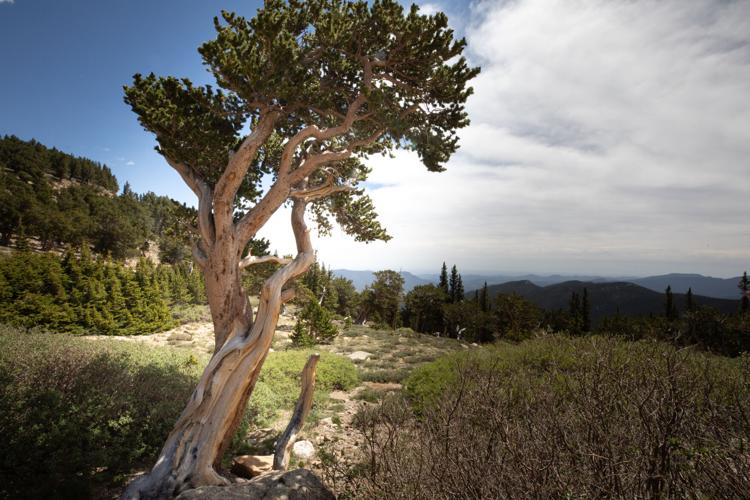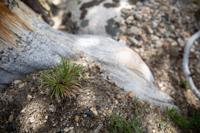CLEAR CREEK COUNTY • High on the craggy shoulders of Mount Evans, above 11,500 feet where the spruce and fir no longer prevail, an exclamation is heard.
Observes one in a group visiting from California: “They make us feel young!”
They are the bristlecone pine trees that have managed to survived millennia here in the cold and wind, thriving where life seems forlorn.
There’s a German term that applies, krummholz, meaning “crooked wood.” Gusts over time have bent the trunks, giving them their gnarly, ghostly shape. The wind has left sides naked, the bark blasted away.
Says one horticulturalist who regularly visits here, Amy Schneider: “You can see all this exposed wood, which would kill some other trees.”

Bristlecone pines are recognized as the oldest non-clonal species on Earth. Visitors can view a population of these gnarled trees at Mount Goliath Natural Area about an hour west of Denver.
The bristlecone pine is not like other trees. The needles might look familiar, but then there’s the white dots on them. Those are flecks of resin, the great, thick content of which along with the density of the wood keep the pines from decaying anytime soon.
They are strong against forces that doom other trees, including pests and fungi. Lightning merely leaves a mark, a dark scar. Or perhaps that’s fire — though, with little else growing around to help spread, fire doesn’t easily threaten the pines.
All of this, and Schneider finds herself surprised by how little people know of the trees’ legend.

At Mount Goliath Natural Area, ancient Bristlecone Pine trees are plentiful. Bristlecone Pine trees are known for their twisted trunks and branches.
“I don’t think people really know about them,” she says. “Like, they don’t really get it.”
They get it if they stop here at Mount Goliath Natural Area. It’s the destination before the ultimate destination that is the 14,130-foot summit of Mount Evans.
It’s a plot of peculiar earth transitioning from forest to tundra, showcasing the subtle but brilliant array that finds a way in gardens tended by Schneider.
She’s the specialist with Denver Botanic Gardens, which has a long-standing partnership with the U.S. Forest Service to maintain this “living laboratory.” Goliath is made up of stream-fed meadows, alpine turf, talus fields and, yes, the forest that twists and turns.
Benches are arranged before a cluster of the bristlecones, as if for one to sit and commune with relatives of the world’s oldest species.
“Some of these bristlecone pines have lasted on lonely, windswept ridges for more than 2,000 years,” reads a sign inside Goliath’s nature center.

Bristlecone pines at Mount Goliath Natural Area. The trees have managed to survived for millennia, twisted by piercing winds and thriving where life seems forlorn.
They are far from exclusive to this mountain. They grow in extreme reaches around Colorado and the broader West, with the oldest known among them in California. At more than 4,800 years old, Methuselah pre-dates the Great Pyramids at Giza.
While her location is closely guarded, and while other bristlecones grow where people never go, the trees at Goliath are unique for their access, conveniently reached off the continent’s highest paved road. They are called “the northernmost large stand of bristlecone pines in North America.”
Which explains the fervor to protect them decades ago. It wasn’t long after the Mount Evans road opened in 1931 that people were found to be damaging the old sentinels, chopping them for souvenirs and firewood. The Forest Service set aside 200 acres to be what is now a designated research natural area.
Research here in 1972 found the oldest tree to be from the year 403 (about 70 years before the Roman Empire fell). Ensuing research found earlier origins among the pines that reproduce by wind-ferried pollen.
Big and small in their life stages, the sight of these might be more poignant considering a recent study by the Forest Service. Scientists found relatives in Utah and California — those of the older, rarer Great Basin variety — under threat. Mortality was linked to climate change and to passing-by beetles invading other trees in the vicinity.
Research continues at Mount Goliath. It’s not just the trees surveyed, but the smaller plants laying low, like the yellow wallflower, the blue-purple sky pilot, the rosy paintbrush and the red king’s crown.

A bristlecone pine seedling starts its long journey of life at the twisted roots of an older tree at Mount Goliath Natural Area.
“I love every single plant,” Schneider says. “The whole area is fascinating because of the conditions the altitude creates. The summer is maybe seven weeks long, and that’s the entire growing season. The plant has to leaf out, make a flower, somehow get their flowers pollinated, set seed, and then it’s going to snow again the next week.”
Of course, she marvels at the bristlecone pines, too — those unmoving symbols of perseverance. She’ll be spotted gazing there in a highlighter vest, identifying her official position.
“People will stop and ask me what I’m doing, which I love,” she says. “It’s like, ‘Oh, my gosh, people care!’”












 Your Privacy Choices
Your Privacy Choices